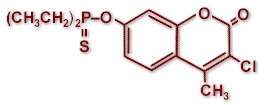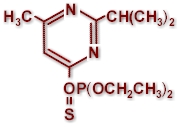Organophosphates (usually abbreviated as OPs) are synthetic chemicals that belong to the organic esters of phosphoric acid. This chemical class was already known since de 19th century, but not their lethal effect on many parasites. Several extremely toxic compounds discovered around 1930 were used as toxic gases for military purposes.
![]()
The organophosphates with parasiticidal efficacy (insecticides, acaricides, tickicides, etc.) were discovered only in the 1950's. Very soon they were vastly used against agricultural and household pests as well as against veterinary parasites.
Historically, Organophosphates followed the previously introduced organochlorines and helped to replace them when the risks of DDT and other organochlorines became evident in the early 1960's. Organophosphates are not harmless at all, and a few are highly toxic to mammals. Most of them are also very toxic for birds and fish as well. But they do not bio-accumulate in the food chain as organochlorines do, and this feature made them preferable to organochlorines.
All organophosphates are veteran antiparasitics, i.e., they have lost patent protection long ago and are available as generics manufactured by numerous chemical companies (typically in China, India, Israel, Brazil, etc.).
Click here for a general introduction to ectoparasiticides and their most important features.
Mode of action and characteristics of organophosphates
Organophosphates act on the nervous system of the parasites (but also of mammals, birds, fish and many organisms!) as inhibitors of acetylcholinesterase (also known as AchE), an enzyme that hydrolyzes acetylcholine (Ach) . Ach is a molecule involved in the transmission of nervous signals from nerves to muscles (so-called neuromuscular junctions) and between neurons in the brain (so-called cholinergic brain synapses). AchE's role is to terminate the transmission of nervous signals where acetylcholine is the neurotransmitter (there are several other neurotransmitters).
By inhibiting the activity of AchE, organophosphates prevent the termination of those nervous signals, i.e. the neurons remain in constant activity and excitation, massively disturbing the normal movements of the parasites. The bottom line for the parasites is that they are paralyzed and die more or less quickly. Organophosphates bind irreversibly to AchE, in contrast with carbamates , another chemical class of parasiticides, which bind reversibly to AchE.
Parasiticidal efficacy of organophosphates
Many organophosphates have a broad spectrum of activity, i.e. they act against a large number of external parasites of different groups: insects (e.g. flies, mosquitoes, fleas, lice, etc.), ticks, mites, etc. They may be effective against both adult and immature stages (larvae, nymphs, etc.).
Most organophosphates act by contact with the parasite, and a few are also systemic, i.e. they get into the bloodstream of the host and reach the parasite inside the host or during its blood meal.
A few organophosphates also have anthelmintic efficacy, i.e. they are effective against various parasitic worms (helminths) of animals, e.g. coumaphos, dichlorvos, trichlorfon, etc. They were vastly used as drenches or even injectables in the 1950's to 1970's, before the discovery of better and safer anthelmintics (e.g. benzimidazoles, levamisole, etc.). Their anthelmintic use has vastly disappeared except in a few countries where a few compounds are still approved for this use. After oral administration or injection organophosphates have very low safety margin for livestock, i.e. the risk of overdosing and subsequent posoning is significant.
The residual effect of organophosphates (i.e. persistence on the host; or length of protection) depends on each compound's chemical structure, on the way it is applied, and on the host. Some organophosphates are very volatile (e.g. dichlorvos) and will evaporate from the host in a few days. Others have high affinity for wool lipids (e.g. diazinon) and may remain active there for months.
Active ingredients
The organophosphates most used against veterinary parasites of livestock, horses and pets are the following:
- Azamethiphos: insecticide, used mainly in baits against houseflies
- Chlorfenvinphos: tickicide, scabicide, louisicide, larvicide, insecticide
- Chlorpyrifos:btickicide, insecticide
- Coumaphos: tickicide, scabicide, louisicide, larvicide, insecticide
- Diazinon = Dimpylate: scabicide, louisicide, larvicide, insecticide
- Dichlorvos = DDVP: insecticide, larvicide
- Ethion: tickicide, insecticide, larvicide
- Fenitrothion: insecticide
- Fenthion: insecticide, larvicide
- Malathion: insecticide, acaricide
- Phosmet: insecticide, lousicide
- Phoxim: scabicide, acaricide, lousicide
- Trichlorfon = Metrifonate: insecticide, larvicide
All these compounds are "veteran" parasiticides: they were discovered and introduced between 1950 and 1970. Numerous other organophosphates were used in Animal Health in the past, but have been abandoned in most or all countries in the last years for various reasons. For many compounds there are safer alternatives. Other compounds have become ineffective due to resistance development by the target pests.
Some manufacturers have phased out numerous organophosphate products for commercial reasons (e.g. because they are no more profitable) or to improve the corporate image (e.g. to get rid of "poisons"). And regulatory authorities (e.g. in the EU, the USA, Australia) have put significant pressure on manufacturers in order to substitute numerous organophosphates, e.g. by asking for additional studies upon scheduled or unscheduled renewal of marketing authorizations. Such studies may be too expensive to perform for old products at the end of their product life-cycle and many manufacturers decide to phase them out.
Nevertheless, organophosphates are still vastly used worldwide on livestock, horses and pets, as well as in agriculture and hygiene. The trend for organophosphates in the Animal Health industry points downwards since their peak in the 1980s, when synthetic pyrethroids were introduced that are significantly less toxic to mammals and birds than organophosphates. However, in the last decades resistance of certain parasites (e.g. horn flies, Boophilus cattle ticks, poultry mites, etc.) to synthetic pyrethroids has developed much faster and stronger than resistance to organophosphates. As a consequence, organophosphate usage in several countries has experienced a certain revival after its previous decline.
Delivery forms of organophosphates

For use in livestock and horses organophosphates are marketed mainly as concentrates for dipping and spraying. Typical formulations are emulsifiable concentrates (EC) and wettable powders (WP). Since most organophosphates are not soluble in water, these products are designed to produce a stable emulsion of the active ingredient when mixed with water. Such concentrates are typically used against ticks, mites, flies, lice, fleas, etc.
Pour-ons (= backliners) with organophosphates are less frequent, although their usage has increased in the last years in some regions (e.g. in Latin America). They are used mainly against flies and lice on cattle.
Organophosphates are also used in insecticide-impregnated ear-tags for the control of flies on cattle.
Many ready-to use topical products (dressings) against fly maggots (screwworms, blowfly strike, etc.) contain organophosphates too.
Organophosphates are frequently mixed with other active ingredients, mainly with synthetic pyrethroids.
For use in dogs and cats organophosphates are still broadly used in collars as well as in insecticidal shampoos, soaps, powders, sprays and the like. However, the usage of organophosphates on pets is substantially smaller than on livestock.
Safety of organophosphates

Strict compliance with safety and use instructions in the product label is a must when dealing with organophosphorous compounds, especially with concentrates for dipping and spraying. Otherwise the risk of serious poisoning of both operators and animals is real. Correctly used, organophosphates are well tolerated by livestock and pets. However, cats, poultry and other domestic birds may not tolerate some organophosphates (e.g. diazinon).
It is also essential to correctly store such products, especially avoiding high temperatures, never used them after the expiry date, and to consume all the product in open containers within the deadline indicated in the label (if there is no indication, ensure that this is done within a few weeks, better within a few days). It is important to know that some organophosphates (e.g. diazinon) can break down to much more toxic compounds when improperly stored.
Organophosphates are problematic for the environment. They do not accumulate in the food chain because they are usually either metabolized through microorganisms in the soil or otherwise break down to less toxic molecules in the soil. Usually they are also metabolized by treated animals and excreted metabolites are not toxic. However, organophosphates are especially toxic to birds. The detrimental effect of organophoshorous tickicides on birds that fed dead ticks fallen from treated cattle was a well known effect observed worldwide at the time when such tickicides were broadly used.
It is therefore very important to follow the label instruction for the disposal of dipping solutions or any other product remainders. In some countries such instructions are so strict and consequently so expensive, that treatment costs of such products becomes prohibitive.
Depending of the active ingredient, the formulation and the application, organophosphates leave residues in meat, milk, eggs and/or wool, also after topical application (e.g. dipping or spraying). Corresponding withholding periods are established by national authorities. In most countries, formulations with organophosphates for dipping or spraying are not allowed for use on dairy cattle, sheep, or goat.
Additional specific information (toxicity, intoxication symptoms, adverse drug reactions, antidote, etc.) on the safety for veterinary use of most used organophosphates is available in specific articles in this site:
- Chlorfenvinphos Safety
- Chlorpyrifos Safety
- Coumaphos Safety
- Diazinon = Dimpylate Safety
- Dichlorvos = DDVP Safety
- Fenthion Safety
- Phoxim Safety
- Trichlorfon = Metrifonate Safety
General safety information for antiparasitics is available in specific articles in this site (click to visit):
- General safety of antiparasitics for domestic animals
- General safety of antiparasitics for humans
- General safety of antiparasitics for the environment
|
WARNING Never use livestock, horse or poultry products on dogs and/or cats, unless explicitly approved for dogs and/or cats too. Without reliable use instructions they can be easily overdosed, and pets may not tolerate formulations developed for use on livestock, horses and/or poultry. Some active ingredients may be toxic to particular animals. Never use agricultural or hygiene products on livestock, horses, poultry or pets, unless explicitly approved for veterinary use, which is quite unusual. Even if the specific active ingredient is approved for some veterinary use. The formulations for agricultural and/or hygiene use are mostly different than those for veterinary use and may be toxic to or not be tolerated by animals. It is obvious that veterinary medicines are not intended for and should never be used on humans!!! |
Resistance of parasites to organophosphates
Resistance of several external parasites as well as numerous household (e.g. cockroaches, termites) and agricultural pests to organophosphates is very frequent worldwide. External veterinary parasites most affected by organophosphate resistance are horn flies, houseflies, Boophilus cattle ticks, blowflies, sheep lice, red poultry mites, fleas and mosquitoes.
Field resistance to organophosphates is mostly low to moderate (resistance factors <100). The practical consequence is that many products still may show some efficacy against resistant parasites, but control will be incomplete and the protection period may be substantially shortened.
Organophosphate resistant parasites usually have cross-resistance with carbamates and vice-versa, i.e., when a parasite has become resistant to organophosphates, it is most likely that it will be resistant to carbamates too.
Visit also the section in this site about parasite resistance to antiparasitics and more spcifically to organophosphates.